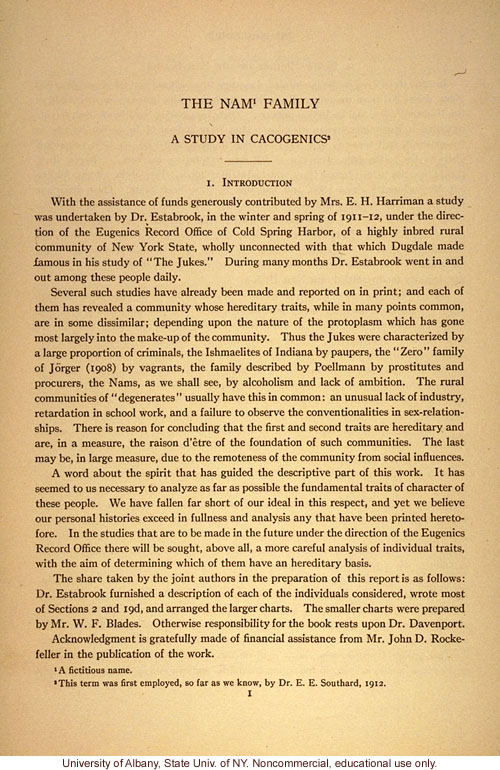The Nam[superior 1] Family
A Study in Cacogenics[superior 2]
[centered score]
I. Introduction
With the assistance of funds generously contributed by Mrs. E. H. Harriman a study was undertaken by Dr. Estabrook, in the winter and spring of 1911-12, under the direction of the Eugenics Record Office of Cold Spring Harbor, of a highly inbred rural community of New York State, wholly unconnected with that which Dugdale made famous in his study of "The Jukes." During many months Dr. Estabrook went in and out among these people daily.
Several such studies have already been made and reported on in print; and each of them has revealed a community whose hereditary traits, while in many points common, are in some dissimilar; depending upon the nature of the protoplasm which has gone most largely into the make-up of the community. Thus the Jukes were characterized by a large proportion of criminals, the Ishmaelites of Indiana by paupers, the "Zero" family of J[umlaut over 'o']rger (1908) by vagrants, the family described by Poellman by prostitutes and procurers, the Nams, as we shall see, by alcoholism and lack of ambition. The rural communities of "degenerates" usually have this in common: an unusual lack of industry, retardation in school work, and a failure to observe the conventionalities in sex-relationships. There is a reason for concluding that the first and second traits are hereditary and are, in large measure, the raison d'etre of the foundation of such communities. The last may be, in large measure, due to the remoteness of the community from social influences.
A word about the spirit that has guided the descriptive part of this work. It has seemed to us necessary to analyze as far as possible the fundamental traits of character of these people. We have fallen far short of our ideal in this respect, and yet we believe our personal histories exceed in fullness and analysis any that have been printed heretofore. In the studies that are to be made in the future under the direction of the Eugenics Record Office there will be sought, above all, a more careful analysis of individual traits, with the aim of determining which of them have an hereditary basis.
The share taken by the joint authors in the preparation of this report is as follows: Dr. Estabrook furnished a description of each of the individuals considered, wrote most of Sections 2 and 19d, and arranged the larger charts. The smaller charts were prepared by Mr. W. F. Blades. Otherwise responsibility for the book rests upon Dr. Davenport.
Acknowledgment is gratefully made of financial assistance from Mr. John D. Rockefeller in the publication of the work.
[superior 1] A fictitious name.
[superior 2] This term was first employed, so far as we know, by Dr. E. E. Southard, 1912.
I
[end]


